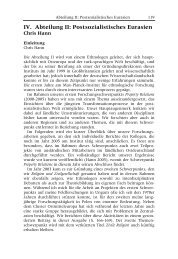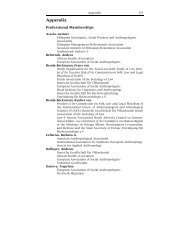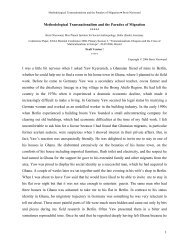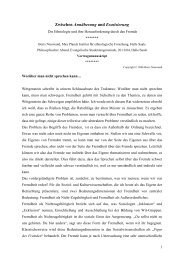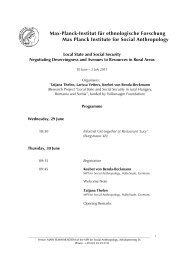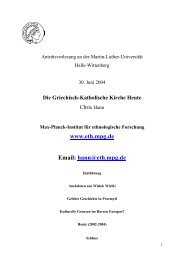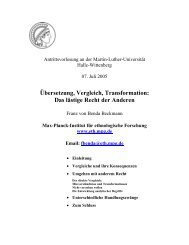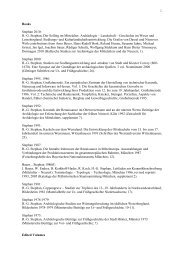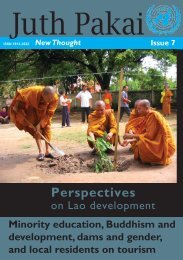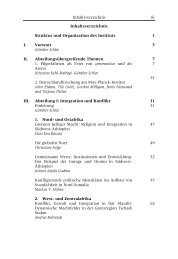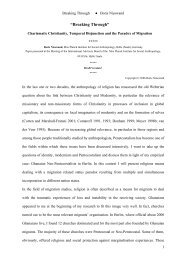ETHNOPOLITICS AND GAbRA ORIGINS - Max-Planck-Institut für ...
ETHNOPOLITICS AND GAbRA ORIGINS - Max-Planck-Institut für ...
ETHNOPOLITICS AND GAbRA ORIGINS - Max-Planck-Institut für ...
You also want an ePaper? Increase the reach of your titles
YUMPU automatically turns print PDFs into web optimized ePapers that Google loves.
historians are, who provide a less simplistic view. On this issue, Jan Hultin (personal<br />
communication) offers the following observations:<br />
“A. K. mentions (notes, p. 190) interviews with two Boran oral historians. One of them (or<br />
both of them?) lives in Nairobi. (...) I have heard of one of them, Dabassa Guyo. When I was<br />
in Nairobi the other year, two Oromo from Wollega told me about a ‘Hayyu Debessu<br />
Guyoo’ who, according to them and what I jotted down in my notebook, is ‘teaching Oromo<br />
history, culture, religion, everything. Dr. Gemetchu was here for many years learning from<br />
him. He lives at the last stop of busses number 1 and 2. He was Gemetchu’s main source.<br />
Many foreigners are learning from him. He is teaching every day throughout the week. You<br />
pay 500 shillings per month for his teaching. He is teaching in small groups, foreigners in<br />
one group etc. He is not a rich man.’<br />
Now, this may be gossip and rumours. But that is not the point. The point is that if<br />
anthropologists use the same sources (elders, experts, oral historians etc.) this creates<br />
problems that deserve to be discussed. These are the problems [reminiscent] of the ones dealt<br />
with by Lyn Schumaker in her book Africanizing Anthropology (2001). And if the ‘local<br />
experts’, ‘elders’, hayyu, or whatever increase their reputation because anthropologists and<br />
other foreigners regard them (or thereby make them) experts, this may create some<br />
epistemological problems (how are these sources influenced by such contact; how are they –<br />
the oral historians etc. – ‘inherited’ by anthropologists; not to speak of how they are<br />
influenced by teaching as gurus to new age romantics and what not).<br />
I suppose there may be other Boran ‘oral historians’ further to the north, in northern Kenya<br />
and Ethiopia. As it is now, the section on A Perspective from Boran Oral Tradition (pp. 182–<br />
185 et pas.) seems to be based mainly on the two persons mentioned in notes on p. 190 – and<br />
on Gemetchu.” (personal communication with Jan Hultin)<br />
To base one’s conclusions on the views of authorities may be a questionable procedure anyhow,<br />
and to base them on questionable authorities, which do not even seem to be sources independent of<br />
each other, is an even more questionable method. I prefer to compare many sources of different<br />
kinds, check their internal consistency and that with each other, and then to come to my own<br />
conclusions.<br />
I shall now address some ethnographic questions in the order of her presentation. This implies<br />
that some of my comments are related to her central thesis, others not.<br />
Kassam (2006: 173) calls the Gabra phratries (“the five drums”) semi-exogamous. I would call<br />
them largely endogamous. Without having figures, I would claim that most marriages are entered<br />
into within a phratry. This has to do with the spatial separation Kassam mentions. Marriage is often<br />
entered into with the other moiety (Jiblo/Yiblo versus Lossa) within a phratry. These moieties<br />
might therefore be called semi-exogamous. Tendencies towards exogamy at the moiety level,<br />
could, by the way, have been linked to wider (early, only partly persisting) Oromo patterns, in<br />
support of her emphasis on Oromo links.<br />
The religious chants of the Gabra contain non-Oromo words. Kassam (2006: 174) is right on this<br />
and also on pointing to Sufi influences. In fact, the name of the chants, dikira, is derived from<br />
5



